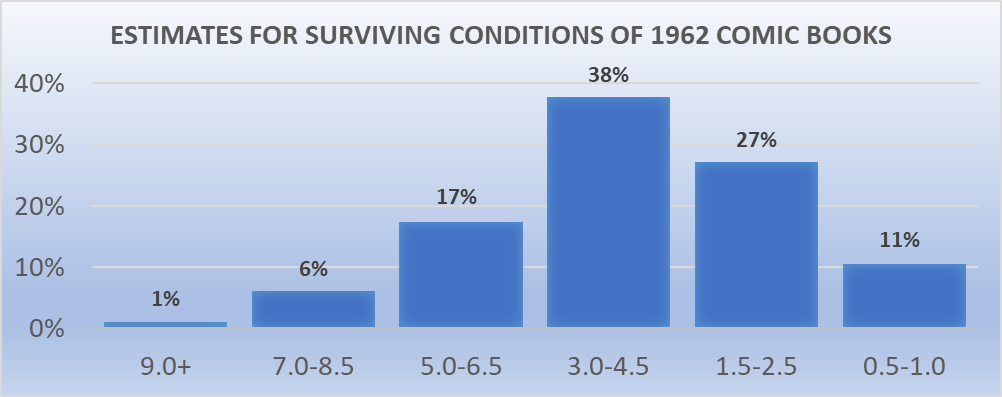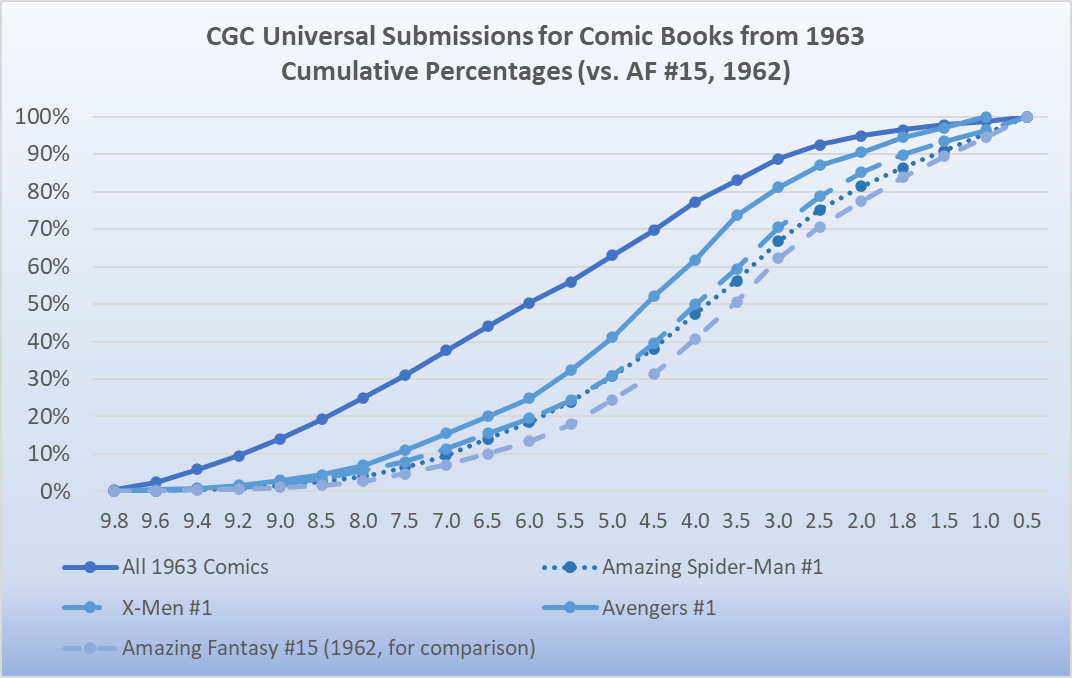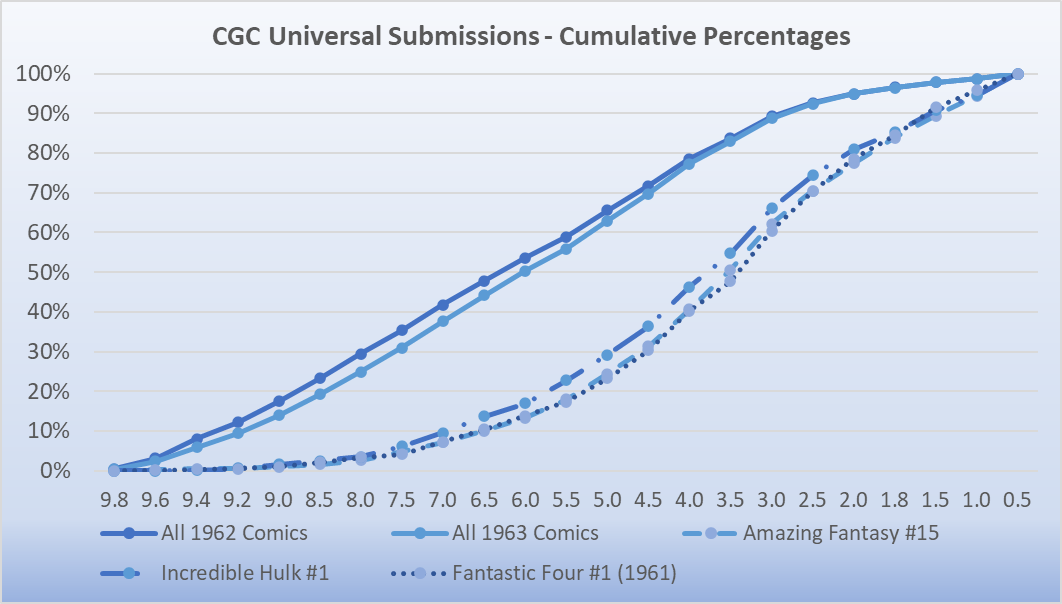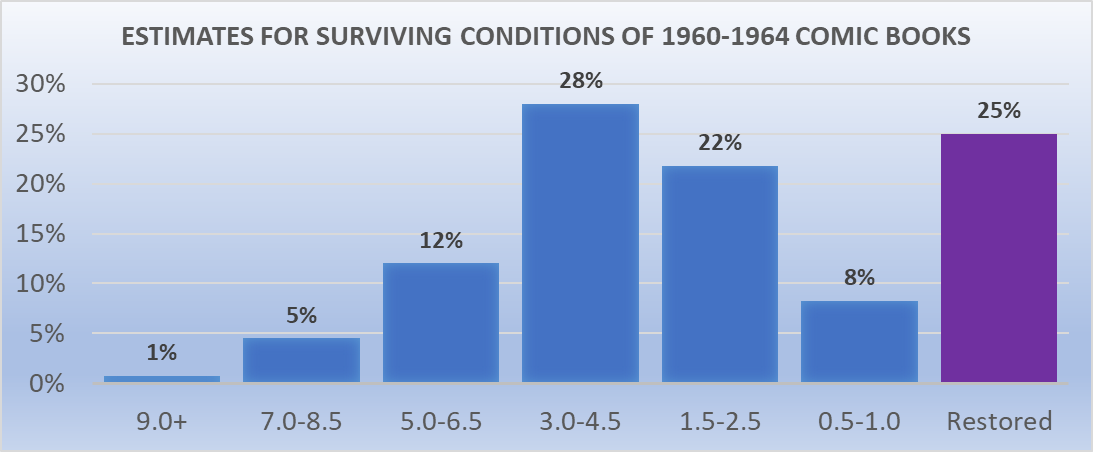The Early 1960s Beyond Amazing Fantasy #15 (And How Much Restoration)?
This article is Part 3 in a continuing series:
Part 1 - How far do CGC average grades drop as comics get older?
Part 2 - What can the CGC Census tell us about all those ungraded comics?
In previous articles, it was established that the highest valued comic books being submitted to CGC in all existing grades should be a better representation of what conditions might be expected to exist for other comic books of the same age, even if they are never submitted to CGC.
Just One Year - 1962
Because there is a significant financial incentive to submit even the lowest grade copies of certain books like Amazing Fantasy #15, the CGC Census grade distributions for Amazing Fantasy #15 are likely to be a good representation of all existing copies of not only Amazing Fantasy #15 but perhaps all 1962 comic books as well. The similarity of other 1962 books like Incredible Hulk #1 and Journey Into Mystery #83 to Amazing Fantasy #15 CGC Census grade distributions in the prior article provided evidence for this conclusion, but the precision of the 25 individual grades from CGC 0.5 to CGC 10 are too specific to apply to an estimate for other books. Groupings for raw grades as shown below give a more reasonable view of the likely grades for surviving comic books from 1962, even if the vast majority of 1962 comic books

Beyond 1962
To estimate the conditions of existing comic books using the CGC Census, it is important to identify the comics most often submitted to CGC even in the lowest possible grades. Moving one year forward from 1962 to 1963, the most frequently submitted 1963 books for the lowest CGC grades of 0.5 and 1.0 are Amazing Spider-Man #1, X-Men #1, and Avengers #1. The CGC grade distributions for these three books are shown in contrast to the overall grade distribution for all 1963 comic books submitted to CGC.

A nearly-identical relationship is observed for the CGC grade distribution percentages for Amazing Spider-Man #1 and X-Men #1, while the percentages for Avengers #1 are significantly different. One explanation would be that the lowest grade copies of Avengers #1 may be less valuable than either Amazing Spider-Man #1 or X-Men #1 in the same conditions, and there has been less financial incentive to submit lower condition copies of Avengers #1. This suggestion is a simple test for GPAnalysis.com.
The GPAnalysis.com 12-month average price recorded for CGC 1.0 Amazing Spider-Man #1 is $3,057. The GPA 12-month average for CGC 1.0 X-Men #1 is $2,308, and the GPA 12-month average for CGC 1.0 Avengers #1 is $942. Perhaps more importantly for evaluating CGC grade distributions for Avengers #1 is the fact that the GPA 12-month average is below the $2,308 price level of CGC 1.0 X-Men #1 for all grades below CGC 4.0 for Avengers #1. This difference in values is the most likely explanation for the difference in CGC grade distributions for Avengers #1 at lower grades when compared to Amazing Spider-Man #1 and X-Men #1. An increase in the value of the lowest condition comic books also increases the likelihood that the lower condition copies are being regularly submitted to CGC, as should be expected. The question of “how much increase in likelihood” is starting to become clearer in this type of analysis.
Including the CGC grade distributions for Amazing Fantasy #15 (1962) for comparison on the chart for 1963 shows the additional percentages of lower condition copies submitted to CGC when the GPAnalysis.com 12-month average is even higher than the $3,057 observed for CGC 1.0 Amazing Spider-Man #1. The GPA 12-month average for CGC 1.0 Amazing Fantasy #15 is $9,225.

No other comic books from the 1960s and very few comic books of any age approach a $9,225 average price for CGC 1.0 condition in the current market. Therefore, few comic books will be representative of all existing conditions on the CGC Census because few comic books have significant values in the lowest possible conditions. With that limitation, there is still quite a bit of interesting data in the CGC Census for estimating the existing conditions of comic books, whether CGC graded or not.
Five Years – 1960 to 1964
The three highest valued CGC 1.0 comic books of the early 1960s are currently CGC 1.0 Amazing Fantasy #15 (1962) at $9,225, CGC 1.0 Incredible Hulk #1 (1962) at $5,187, and CGC 1.0 Fantastic Four #1 (1961) at $4,982. Their CGC Census grade distributions are nearly identical to each other but quite different from the CGC submissions for all books from 1962 or 1963.

Grouping these grades into fewer categories, the three highest valued books of the early 1960s show only slight differences in the CGC grade distributions. The largest difference is just 6% for the grouping combining four grades - CGC 1.5, 1.8, 2.0, and 2.5 noted as 1.5-2.5 in the chart below.

The consistency of the grade distributions for these three books should not be assumed to apply across the board. Note the much larger differences to the grade groupings when another key issue from this timeframe, Avengers #1 (1963), is added to the same chart.

The largest difference when including Avengers #1 (1963) is now 15% for the grouping of 1.5-2.5 and the groupings for 7.0-8.5 and 9.0+ are about doubled in percentage for Avengers #1. While it is true that many ungraded copies of all four issues still exist, it is very likely that low grade copies of Avengers #1 are underrepresented on the CGC Census compared ungraded copies remaining for the other three books of higher value.
Understanding that Avengers #1 (1963) is a highly-desirable issue, it should be recognized that almost all comic books (including most key issues) have CGC Census grade distributions which do not accurately reflect the lower grade distributions of the existing copies. The available evidence for all grades is limited in this early 1960s timeframe since many key issues are not well-represented on the CGC Census if there is a low value for the lowest conditions. As a result, the estimated grade distributions of all surviving comic books from a five-year range (1960-1964) are likely to be very similar to the estimated CGC Census grade distributions the top 3 most valuable books for the timeframe, combined to produce the chart below.

What About Restoration?
The estimates produced in these analyses are for universal grades (non-restored) of surviving comic book conditions. Comic books which have been identified with restoration by CGC represent only 1% of the total comic books graded by CGC, but it would be beneficial to determine what percentage of the three comic books in the 1960-1964 estimate have been identified as restored. According to the CGC Census, a total of 7,577 copies of Amazing Fantasy #15, Incredible Hulk #1, and Fantastic Four #1 have been graded and 1,880 of those are CGC restored grades. That’s 25%. Individually, the CGC restored notation for each book is Amazing Fantasy #15 at 26%, Incredible Hulk #1 at 22%, and Fantastic Four #1 at 25% - which is consistently about one-in-four copies submitted to CGC having restoration. Adjustments to the chart for 1960-1964 surviving condition estimates to include 25% having restoration results are shown below.

Restoration, as identified by CGC, includes both amateur attempts to improve a comic’s appearance and professional restoration which is done specifically to the highest valued comic books. The CGC Census does separate amateur (low quality) restoration from professional (high quality) restoration, and the 1,880 CGC restored grades for the three comics (Amazing Fantasy #15, Incredible Hulk #1, and Fantastic Four #1) reflect 30% as professional restoration. An adjustment to approximately 18% of surviving 1960-1964 comic books having restoration might be appropriate, rather than the 25% shown in the chart. However, it is also plausible that restored books are not submitted to CGC as often as universal grades, even for the highest valued comic books, since there is less financial incentive to have CGC grading performed for comic books which are already known to have restoration. It is reasonable to keep the 25% restoration estimate for comic books from 1960-1964, representing both amateur attempts over the past six decades as well as professional restoration performed for comics of higher values.
About the Author
 |
Greg Holland has collected comic books for over 30 years and has been the administrator of the CGC Census Analysis website since 2003, currently located at CGCdata.com. He is the 1999 founder of the ValiantComics.com website and the 2004 ValiantFans.com message board. Dr. Holland holds a Ph.D. in information quality from the University of Arkansas at Little Rock and has held data science positions as research director, analyst, and administrator for government, corporations, and university. Active on the CGC Forums as ‘valiantman’ since 2002, he is also a 15+ year advisor to the Overstreet Comic Book Price Guide and contributor to later editions of the Standard Catalog of Comic Books. Greg resides in Arkansas, USA, with his wife of 23 years and their daughter. |
Related news
24 Oct 2022
Canadian Price Variants (CPVs) and GPAnalysis.com Recorded Sales
With Canadian Price Variants recorded in GPAnalysis.com for decades, what can the data tell us about rarity and value when comparing against direct editions?
Read more26 May 2022
CGC Census - A Game for the Thousandth Collector
Imagine a game where 1,000 lucky comic collectors are awarded the best available copies of comic books from the CGC Census. Where would ticket #1,000 be for the earliest appearances of favorite characters? Some winning books may surprise you.
Read more